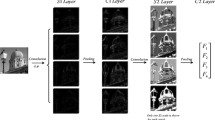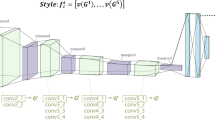Abstract
The biologically inspired model (BIM) for invariant feature representation has attracted widespread attention recently, which approximately follows the organization of cortex visuel. BIM is a computational architecture with four layers. With the image data size increases, the four-layer framework is prone to be overfitting, which limits its application. To address this issue, motivated by biology, we propose a biologically inspired hierarchical model (BIHM) for image feature representation, which adds two more discriminative layers upon the conventional four-layer framework. In contrast to the conventional BIM that mimics the inferior temporal cortex, which corresponds to the low level feature invariance and selectivity, the proposed BIHM adds two more layers upon the conventional BIM framework to simulate inferotemporal cortex, exploring higher level feature invariance and selectivity. Furthermore, we firstly utilize the BIHM in the image recommendation. To demonstrate the effectiveness of proposed model, we use it in image recommendation task and perform experiment on CalTech5 datasets. The experiment results show that BIHM exhibits higher performance than conventional BIM and is very comparable to existing architectures.
Access this chapter
Tax calculation will be finalised at checkout
Purchases are for personal use only
Similar content being viewed by others
References
Wu, L., Jin, R., Jain, A.K.: Tag completion for image retrieval. IEEE Trans. Pattern Anal. Mach. Intell. 35, 716–727 (2013)
Kim, M., Park, S.O.: Group affinity based social trust model for an intelligent movie recommender system. Multimed. Tools Appl. 64, 505–516 (2013)
Wang, J., Shim, B.: On the recovery limit of sparse signals using orthogonal matching pursuit. IEEE Trans. Signal Process. 60, 4973–4976 (2012)
Viana, W., Braga, R., Lemos, F.D.A., Souza, J.M.O., Carmo, R.A.F., Andrade, R.M.C., et al.: Mobile photo recommendation and logbook generation using context-tagged images. IEEE Multimed. 21, 24–34 (2014)
Wan, J., Wang, D., Hoi, S.C.H., et al.: Deep learning for content-based image retrieval: a comprehensive study. In: 22nd ACM International Conference on Multimedia, pp. 157–166. ACM, Orlando (2014)
Babenko, A., Slesarev, A., Chigorin, A., Lempitsky, V.: Neural codes for image retrieval. In: Fleet, D., Pajdla, T., Schiele, B., Tuytelaars, T. (eds.) ECCV 2014. LNCS, vol. 8689, pp. 584–599. Springer, Cham (2014). doi:10.1007/978-3-319-10590-1_38
Donahue, J., Anne, H.L., Guadarrama, S., Rohrbach, M., Venugopalan, S., Saenko, K., et al.: Long-term recurrent convolutional networks for visual recognition and description, pp. 2625–2634 (2015)
Habibian, A., van de Sande, K.E.A., Snoek, C.G.M.: Recommendations for video event recognition using concept vocabularies. In: 3rd ACM Conference on International Conference on Multimedia Retrieval, pp. 89–96. ACM, New York (2013)
Tam, K.P.: Concepts and measures related to connection to nature: similarities and differences. J. Environ. Psychol. 34, 64–78 (2013)
Hubel, D.H., Wiesel, T.N.: Receptive fields of single neurones in the cat’s striate cortex. J. Physiol. 148, 574–591 (1959)
Hubel, D.H., Wiesel, T.N.: Receptive fields, binocular interaction and functional architecture in the cat’s visual cortex. J. Physiol. 160(1), 106–154 (1962)
Poggio, T., Girosi, F.: Networks for approximation and learning. Proc. IEEE 78, 1481–1497 (1990)
Riesenhuber, M., Poggio, T.: Hierarchical models of object recognition in cortex. Nat. Neurosci. 2, 1019–1025 (1999)
Qiao, H., Xi, X., Li, Y., Wu, W., Li, F.: Biologically inspired visual model with preliminary cognition and active attention adjustment. IEEE Trans. Cybern. 45, 2612–2624 (2015)
Qiao, H., Li, C., Yin, P., Wu, W., Liu, Z.Y.: Human-inspired motion model of upper-limb with fast response and learning ability – a promising direction for robot system and control. Assem. Autom. 36, 97–107 (2016)
Serre, T., Wolf, L., Bileschi, S., Riesenhuber, M., Poggio, T.: Robust object recognition with cortex-like mechanisms. IEEE Trans. Pattern Anal. Mach. Intell. 29, 411–426 (2007)
Mutch, J., Lowe, D.G.: Multiclass object recognition with sparse, localized features. In: IEEE Computer Society Conference on Computer Vision and Pattern Recognition, New York, vol. 1, pp. 11–18 (2006)
Lu, Y.F., Zhang, H.Z., Kang, T.K., Choi, I.H., Lim, M.T.: Extended biologically inspired model for object recognition based on oriented Gaussian-Hermite moment. Neurocomputing 139, 189–201 (2014)
Lu, Y.F., Kang, T.K., Zhang, H.Z., Lim, M.T.: Enhanced hierarchical model of object recognition based on a novel patch selection method in salient regions. IET Comput. Vis. 9, 663–672 (2015)
Lu, Y.F., Zhang, H.Z., Kang, T.K., Lim, M.T.: Dominant orientation patch matching for HMAX. Neurocomputing 193, 155–166 (2016)
Zhang, H.Z., Lu, Y.F., Kang, T.K., Lim, M.T.: B-HMAX: a fast binary biologically inspired model for object recognition. Neurocomputing 218, 242–250 (2016)
Serre, T., Riesenhuber, M.: Realistic modeling of simple and complex cell tuning in the HMAX model, and implications for invariant object recognition in cortex (2004)
Chang, C.C., Lin, C.J.: LIBSVM: a library for support vector machines. ACM Trans. Intell. Syst. Technol. 2, 1–27 (2011)
Lowe, D.G.: Distinctive image features from scale-invariant keypoints. Int. J. Comput. Vis. 60, 91–110 (2004)
Acknowledgment
This work was supported by the National Science Foundation of China (Grant 61603389) and partially supported by National Natural Science Foundation of China (Grants 61210009, 61502494) and also by the Strategic Priority Research Program of the CAS (Grant XDB02080003).
Author information
Authors and Affiliations
Corresponding author
Editor information
Editors and Affiliations
Rights and permissions
Copyright information
© 2017 Springer International Publishing AG
About this paper
Cite this paper
Lu, YF., Qiao, H., Li, Y., Jia, LH., Zhang, AX. (2017). A Novel Biologically Inspired Hierarchical Model for Image Recommendation. In: Cong, F., Leung, A., Wei, Q. (eds) Advances in Neural Networks - ISNN 2017. ISNN 2017. Lecture Notes in Computer Science(), vol 10262. Springer, Cham. https://doi.org/10.1007/978-3-319-59081-3_68
Download citation
DOI: https://doi.org/10.1007/978-3-319-59081-3_68
Published:
Publisher Name: Springer, Cham
Print ISBN: 978-3-319-59080-6
Online ISBN: 978-3-319-59081-3
eBook Packages: Computer ScienceComputer Science (R0)




